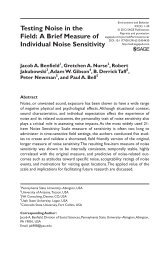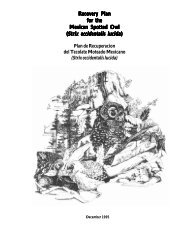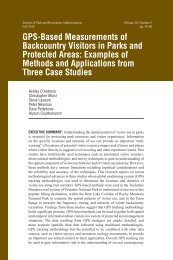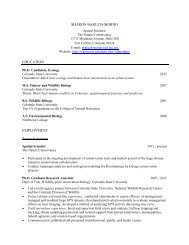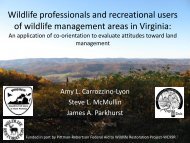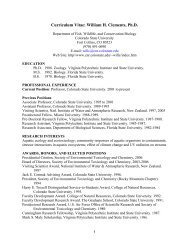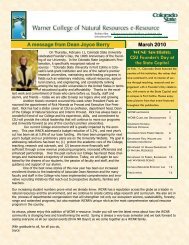RamFire
RamFire
RamFire
You also want an ePaper? Increase the reach of your titles
YUMPU automatically turns print PDFs into web optimized ePapers that Google loves.
Volume 1, Issue 1<br />
Winter 2009-2010<br />
S ttud een tt FF i rr ee ff ightei<br />
rr A ss ssoc c i aa tt ioni<br />
aa tt Colol<br />
rr aado S tt aa tt ee Uni v ee rr ss i tt yy<br />
<strong>RamFire</strong><br />
Discipulus de Ignis<br />
“Student of Fire”<br />
INSIDE THIS ISSUE:<br />
Fire Folks: Paul Gleason 2<br />
A New Look For SFA_____________<br />
Where were they? 3<br />
S130-190 3<br />
The Beetles! 4<br />
Fire Jobs 4<br />
SFA is a proud member of<br />
the WFF 52 Club.<br />
SFA is sponsored in part<br />
by the Supply Cache and<br />
the Colorado Firecamp<br />
Welcome to the new look<br />
for SFA news…<strong>RamFire</strong>!<br />
This will be your one-stop<br />
shop for SFA information,<br />
fire news and notes, fire<br />
photos from members,<br />
and JOBS.<br />
We hope to do this<br />
quarterly during the year<br />
as a way to keep in touch<br />
and keep you informed.<br />
In addition, we will<br />
include articles of interest<br />
and links galore to all<br />
things wildfire.<br />
That being said…send us<br />
your fireline stories,<br />
photos, lessons learned,<br />
openings on your<br />
crew/district, and Haiku if<br />
you got it!<br />
In the meantime, read on<br />
about some interesting<br />
events, people, photos<br />
and fire science at CSU.<br />
Future issues will include<br />
fire alumni contact<br />
information, future fire<br />
courses, training and<br />
certification opportunities,<br />
Fire Hire in 2010, a visit<br />
by a prominent fire<br />
writer, and Paul Gleason<br />
Scholarship news.<br />
SFA<br />
The Colorado State University's Student Firefighter Association (SFA), is an organization comprised<br />
of active, past, and aspiring wildland firefighters; students, professors and researchers.<br />
Our goal is to generate a network linking active fire managers, those getting into fire, and those<br />
researching and teaching about fire. Through this network we hope to improve the fire science<br />
program at CSU, provide greater career training and job opportunities, develop a stronger tie with<br />
active fire management practitioners, and support a cohort of “students of fire” at CSU. The<br />
inaugural chapter has recently been joined by a chapter at the University of Montana/Missoula.<br />
We also want to acknowledge the tremendous contributions to fire education and especially<br />
firefighter safety made by Paul Gleason who taught Fire Science here at CSU.
Page 2<br />
R aam FF i rr ee<br />
F ii rre Fo llks<br />
Paul Gleason<br />
Have you ever dropped a<br />
snag on a fire? Used<br />
LCES? Considered yourself<br />
a student of fire?<br />
If so, you are the<br />
beneficiary of the<br />
legendary contributions to<br />
wildfire management<br />
made by CSU's own Paul<br />
Gleason.<br />
Paul Gleason was<br />
involved in significant fire<br />
events his entire life from<br />
the Loop Fire to the Dude<br />
Fire to Cerro Grande. He<br />
spent 12 years as the<br />
Superintendent of the Zig<br />
Zag Hot Shots before<br />
coming to the Canyon<br />
Lakes Ranger District,<br />
Arapaho-Roosevelt<br />
National Forest as FMO<br />
and fire ecologist.<br />
Upon his mandatory<br />
retirement from the fire<br />
service Paul returned to<br />
his CSU alma mater to<br />
teach fire management<br />
classes in the Forestry<br />
department as well as<br />
S490 to fire managers.<br />
Perhaps Paul’s best known<br />
and most critical<br />
contribution to the fire<br />
culture is LCES, the<br />
mandatory first step in<br />
engaging wildfire. Paul<br />
distilled numerous fatality<br />
fire and shelter<br />
deployment common<br />
factors into the<br />
requirement for Lookouts,<br />
Communication, Escape<br />
Routes and Safety Zones.<br />
He further developed the<br />
concept that LCES is a<br />
dynamic process and not<br />
a static checklist to be<br />
administered only once.<br />
In addition, Paul helped<br />
develop the S212 Wildfire<br />
Powersaws curriculum.<br />
Paul passed away from<br />
cancer in 2003.<br />
Visit the Wildfire Lessons<br />
Learned site to see Paul’s<br />
presentation on Cerro<br />
Grande from his<br />
perspective. Thanks to<br />
Kelly Close, FBAN and<br />
Captain Poudre Fire<br />
Authority for preserving<br />
this presentation.<br />
http://www.wildfirelessons.net/<br />
uploads/Gleason_Video/Gleas<br />
on_512K.wmv<br />
The Paul Gleason Wildland Fire Scholarship<br />
(Top) Paul Gleason in<br />
Oregon---<br />
Superintendent Zig Zag<br />
Hot Shots 1987<br />
(Middle) Dropping a<br />
burning snag 1976<br />
(Bottom) at Storm King<br />
Mountain, Colorado<br />
In honor of Paul Gleason’s<br />
contribution to wildfire<br />
management, students of<br />
fire , and fire science<br />
studies at CSU, the Paul<br />
Gleason Wildland Fire<br />
Scholarship was created<br />
in 2003.<br />
See Leadership<br />
Development and<br />
http://www.wildlandfire.co<br />
m/docs/gleason/memorial.<br />
htm for more information<br />
on Paul and his legacy.<br />
The Paul Gleason<br />
Scholarship is an annual<br />
award provided to<br />
students of fire in WCNR.<br />
Sadly, the Scholarship is<br />
not fully funded at the<br />
present time and must<br />
meet full funding<br />
requirements by October<br />
2010 to remain as a<br />
supporter of future<br />
students of fire.<br />
Efforts are presently<br />
being made to raise the<br />
required funds<br />
(approximately $15,000!)<br />
through alumni donors,<br />
fees from the S130-190<br />
class (See page 3),<br />
special product offerings<br />
from the Supply Cache<br />
and a planned “Students<br />
of Fire” book compilation<br />
of Paul Gleason stories,<br />
anecdotes and firefighter<br />
experiences with LCES.<br />
The Paul Gleason<br />
Wildland Fire<br />
Scholarship Fund<br />
C/O CSU Foundation<br />
P.O. Box 1870<br />
Fort Collins, CO 80522
R aam FF i rr ee<br />
Where were they?<br />
Let us know where you’re<br />
working, unit or crew<br />
name, overtime, fire<br />
activity and fuels in your<br />
neck of the woods. Send<br />
pix!<br />
A few folks we’ve heard<br />
from:<br />
Zach Glover (FRWS<br />
2007), SFA member,<br />
McCall jumper, was<br />
detailed as lead of a novel<br />
10-person plus engine<br />
IA/RX crew on the Payette<br />
NF, Idaho. Zach says this<br />
crew is the template for a<br />
new crew type being<br />
investigated on the<br />
Payette.<br />
Speaking of the Payette,<br />
Travis Chamberlain<br />
(FRWS 2007), worked<br />
with Zach.<br />
Esther Schnur, also of<br />
the Payette (Price Valley<br />
Helitak) has detailed to<br />
Cortez, Colorado as a<br />
SEAT manager. Esther<br />
helped get this SFA thing<br />
going in 2005 and recently<br />
completed her MS in<br />
Forestry right here at<br />
CSU!<br />
S130-190<br />
As part of SFA’s mandate<br />
to provide fire education<br />
and training opportunities<br />
to WCNR students and<br />
SFA members a<br />
partnership has been<br />
formed with CSFS to<br />
provide S130-190 classes<br />
on campus. Each<br />
semester a cadre of CSFS<br />
firefighters join graduate<br />
students who are also<br />
Brian Schroeder (FRWS<br />
2008) was with Prescott<br />
Helitak (Arizona). Their<br />
Bell 212 with LA tanks<br />
was used a number of<br />
times in R5 and R6.<br />
Chris Henry (FRWS<br />
Masters student) and<br />
Brian Henley (FRWS<br />
2007) were with Craig<br />
Hotshots. Brian is now on<br />
an RX burn detail with<br />
FWS in the Southeast.<br />
Jes Steffen, recent past<br />
SFA Co-Chair was a new<br />
member of the<br />
Beckwourth Hot Shots on<br />
the Plumas NF in Northern<br />
California.<br />
Jesse Moreng (FRWS<br />
2007) returned to the<br />
Roosevelt Hot Shots as<br />
sawyer and fireline artist<br />
(he designed the SFA<br />
logo).<br />
Parker Coombs (FRWS<br />
2009) joined the Pike IHC<br />
crew based in Monument<br />
Colorado.<br />
professional firefighters to<br />
implement S130-190. The<br />
class is taught in a hybrid<br />
format with cd-guided<br />
self-study followed by<br />
interactive classroom and<br />
field sessions.<br />
The first two classes have<br />
filled quickly, and plans<br />
are to provide the class<br />
each semester.<br />
Jesse Skrak joined the<br />
Gunnison NF fuels/RX<br />
crew, working for CSU<br />
alum Jeremy Spetter.<br />
Joe Murray (FRWS 2008)<br />
continued to do fuels<br />
mitigation and fire<br />
suppression with the<br />
Larimer County<br />
Emergency Services<br />
mitigation crew and<br />
Yellowjackets fire crew.<br />
Mary Huffman, SFA<br />
member, was recently<br />
named as The Nature<br />
Conservancy’s National<br />
Wildland Fire Training<br />
Manager. In addition, she<br />
recently finished her PhD<br />
program in Forest Science<br />
here at CSU.<br />
Mark Herrington, SFA<br />
member and CSU student<br />
joined the Upper Colorado<br />
River Fire Helitack crew<br />
based out of Rifle,<br />
Colorado.<br />
Where were you<br />
in 2009? Where<br />
you going in<br />
2010? Let us<br />
know!<br />
Plans are being made to<br />
offer S290 and other<br />
classes in the future.<br />
A portion of the class fees<br />
are donated to the Paul<br />
Gleason Scholarship and<br />
WFF.<br />
Next session is<br />
March/April 2010. See the<br />
SFA website for more<br />
information.<br />
Page 3<br />
S oom ee S FFA M eem bb ee rr<br />
Af f i l i aa t i oo nn ss
Page 4<br />
R aam FF i rr ee<br />
WE’RE ON THE WEB!<br />
CLICK ON THE RAM TO GET<br />
TO THE SFA SITE<br />
E-mail:<br />
csuramfire@gmail.com<br />
Ladies and Gentlemen....The Beetles!<br />
Over 2.5 million acres of lodgepole pine forests are estimated to be affected by the latest<br />
Mountain Pine Beetle outbreak in Colorado and southern Wyoming (an estimated 39<br />
million acres in British Columbia!).<br />
With so many acres affected, a palpable fear has been raised in mountain communities<br />
with a perceived increase in fire danger, loss of tourism due to “blighted” forests and<br />
threats to watersheds. Local enterprises are responding in unique ways and federal<br />
funding is spurring economic opportunities related to beetle tree removal.<br />
While the threat of stand replacing crown fires exists as a facet of healthy as well as<br />
diseased lodgepole forests, the next threat from the US Forest Service’s standpoint is that<br />
of falling trees, whose roots are weakened or killed by drought and disease.<br />
Region 2 Forester Rick Cables has secured $49 million for hazard tree mitigation along<br />
forest trails, roads and campgrounds. Funding is also being appropriated for hazard<br />
mitigation along 230 miles of powerline and utility corridors as well as microwave tower<br />
sites. Region 2 estimates that in the heavily hit Medicine Bow, White River, and Arapaho-<br />
Roosevelt National Forests treatment is needed on 911 miles of trails (20% of all trail<br />
miles), 3500 miles of forest roads (40% of all forest road miles), and 22000 acres of<br />
recreational sites (19% of all campsite/picnic area acres)<br />
What to do with all the wood soon to be cut? See http://csfs.colostate.edu/cowood/ for<br />
ideas! See R2 Bark Beetle for more information on the situation, including maps.<br />
So, how will these affected forests react to fire? Here is one take on the issue:<br />
http://www.wy.blm.gov/fireuse/docs/BarkBeetlesFuelsFire.pdf<br />
Fire Jobs<br />
If you are reading this and haven’t started your USAJobs and AVUE applications<br />
yet, or have no idea what AVUE means it’s time to light a fire under you!<br />
Most Federal fire position announcements for 2010 have been released.<br />
Qualified applicant lists for many of these jobs are pulled in early January!<br />
A few hints from the cadre:<br />
1. Having S130/190 completed prior to the season helps.<br />
2. Don’t expect many calls from Hot Shot crews if you have less than a few<br />
seasons experience.<br />
3. Ask friends/classmates about fire crews they have been on or know<br />
about. Not all crews are equal!<br />
4. Consider an engine position<br />
5. Call the places you are interested in and introduce yourself<br />
6. Use career services on campus. Contact Barb Diehl in WCNR for<br />
application and resume assistance:<br />
Barbara.Diehl@colostate.edu 491-2668<br />
7. Doing Pingree this summer? Work with the Yellowjackets!




